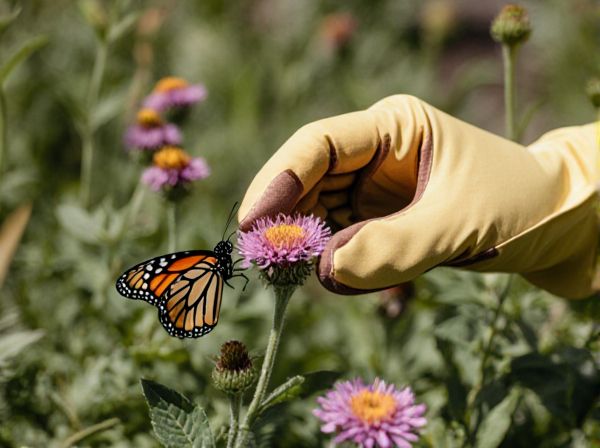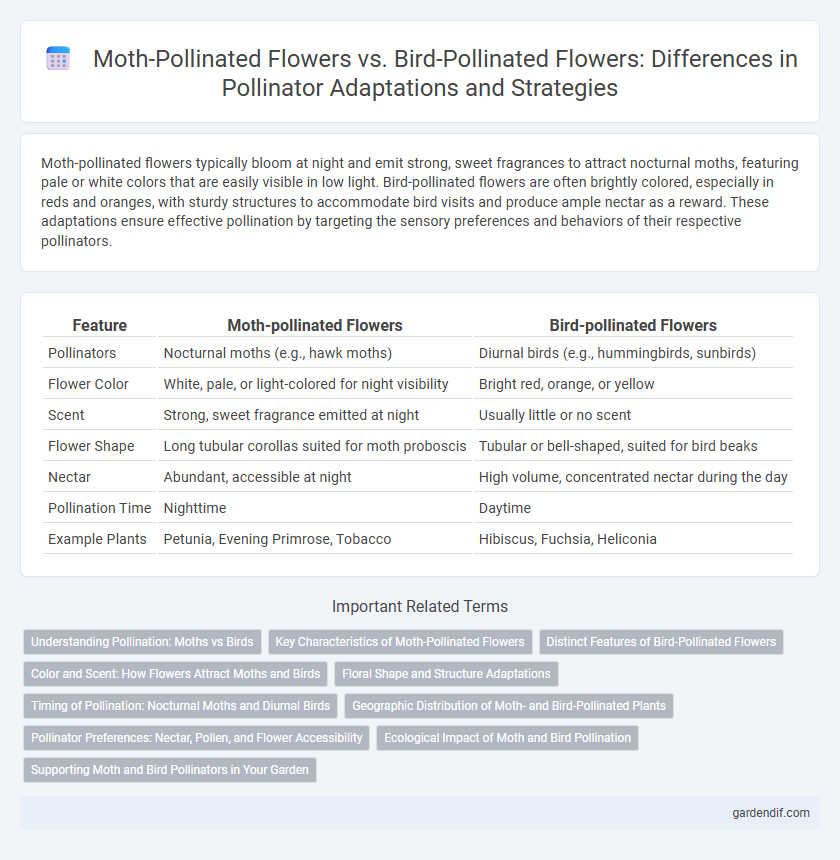
Moth-pollinated Flowers vs Bird-pollinated Flowers Illustration
Moth-pollinated flowers typically bloom at night and emit strong, sweet fragrances to attract nocturnal moths, featuring pale or white colors that are easily visible in low light. Bird-pollinated flowers are often brightly colored, especially in reds and oranges, with sturdy structures to accommodate bird visits and produce ample nectar as a reward. These adaptations ensure effective pollination by targeting the sensory preferences and behaviors of their respective pollinators.
Table of Comparison
| Feature | Moth-pollinated Flowers | Bird-pollinated Flowers |
|---|---|---|
| Pollinators | Nocturnal moths (e.g., hawk moths) | Diurnal birds (e.g., hummingbirds, sunbirds) |
| Flower Color | White, pale, or light-colored for night visibility | Bright red, orange, or yellow |
| Scent | Strong, sweet fragrance emitted at night | Usually little or no scent |
| Flower Shape | Long tubular corollas suited for moth proboscis | Tubular or bell-shaped, suited for bird beaks |
| Nectar | Abundant, accessible at night | High volume, concentrated nectar during the day |
| Pollination Time | Nighttime | Daytime |
| Example Plants | Petunia, Evening Primrose, Tobacco | Hibiscus, Fuchsia, Heliconia |
Understanding Pollination: Moths vs Birds
Moth-pollinated flowers typically exhibit pale or white colors and emit strong, sweet fragrances during nighttime to attract nocturnal moths, whereas bird-pollinated flowers are often brightly colored, especially red or orange, and produce abundant nectar to entice diurnal birds like hummingbirds. Moths rely on scent and visual cues in low light, favoring tubular or trumpet-shaped flowers with a landing platform, while birds use vision to detect conspicuous blooms with sturdy structures that can support their weight. The pollination efficiency of moths depends largely on their long proboscises suited for deep nectar extraction, contrasting with birds' specialized beaks and hovering ability that facilitate pollen transfer across larger distances.
Key Characteristics of Moth-Pollinated Flowers
Moth-pollinated flowers typically exhibit pale or white colors that reflect moonlight, facilitating visibility during nighttime when moths are active. These flowers often produce strong, sweet fragrances and have tubular shapes to accommodate moths' long proboscises for nectar access. Unlike bird-pollinated flowers, which are usually vibrant and diurnal, moth-pollinated flowers emphasize nocturnal attraction strategies and scent-driven pollination.
Distinct Features of Bird-Pollinated Flowers
Bird-pollinated flowers typically exhibit bright red or orange hues and possess tubular shapes to accommodate bird beaks, especially hummingbirds. These flowers produce large quantities of dilute nectar, serving as a high-energy reward for avian pollinators. Unlike moth-pollinated flowers, which often open at night and emit strong, sweet fragrances, bird-pollinated flowers are usually scentless and open during the day to attract daytime foraging birds.
Color and Scent: How Flowers Attract Moths and Birds
Moth-pollinated flowers typically exhibit pale or white colors that enhance visibility in low light conditions and emit strong, sweet fragrances during the night to attract nocturnal moths. In contrast, bird-pollinated flowers are often brightly colored in shades of red, orange, or yellow, with little to no scent, relying on visual cues to draw diurnal birds such as hummingbirds. These distinct adaptations optimize pollination efficiency by aligning floral traits with the sensory preferences of their primary pollinators.
Floral Shape and Structure Adaptations
Moth-pollinated flowers typically exhibit pale or white colors with tubular, narrow shapes and strong nocturnal fragrances to attract moths using their long proboscises. Bird-pollinated flowers often feature bright red or orange hues, sturdy and robust structures, and ample nectar reserves suited to hummingbirds and other birds with specialized beaks. These floral adaptations optimize pollination efficiency by matching the morphology and behavior of their primary pollinators.
Timing of Pollination: Nocturnal Moths and Diurnal Birds
Moth-pollinated flowers typically open and release nectar during nighttime hours, aligning with the nocturnal activity of moths to maximize pollination efficiency. Bird-pollinated flowers, in contrast, exhibit diurnal rhythms, blooming and producing nectar during daylight to attract birds that forage actively during the day. This temporal segregation reduces competition for pollinators and ensures effective pollen transfer across species.
Geographic Distribution of Moth- and Bird-Pollinated Plants
Moth-pollinated flowers predominantly thrive in temperate and tropical regions with high nocturnal activity, such as parts of North America, Southeast Asia, and Australia, adapting to cooler nighttime environments. Bird-pollinated plants are extensively distributed in tropical and subtropical zones, notably in the Americas, Africa, and Australasia, where vibrant flowers and abundant nectar attract hummingbirds, sunbirds, and honeyeaters. These geographic distributions reflect evolutionary adaptations to distinct pollinator behaviors and environmental conditions, influencing floral morphology and pollination efficiency.
Pollinator Preferences: Nectar, Pollen, and Flower Accessibility
Moth-pollinated flowers typically produce abundant, sweet nectar and emit strong nighttime fragrances to attract nocturnal pollinators, with tubular shapes facilitating moth proboscis access. Bird-pollinated flowers often offer copious, dilute nectar as a primary reward and display vivid colors like red or orange, adapting flower structures for beak access and hovering feeding. These differences in nectar concentration, pollen availability, and flower morphology reflect distinct pollinator preferences and optimize pollination efficiency in moths versus birds.
Ecological Impact of Moth and Bird Pollination
Moth-pollinated flowers often exhibit nocturnal blooming and emit strong, sweet fragrances to attract night-active pollinators, contributing to the pollination of plant species that rely on nighttime ecosystems and maintaining biodiversity in these habitats. Bird-pollinated flowers typically have bright colors and abundant nectar, supporting diurnal pollinators such as hummingbirds, which play a crucial role in seed production and the regeneration of diverse plant communities. The ecological impact of moth and bird pollination is significant, as both ensure genetic diversity and resilience in ecosystems by facilitating effective cross-pollination in their respective active periods.
Supporting Moth and Bird Pollinators in Your Garden
Moth-pollinated flowers typically open at night and emit strong, sweet fragrances that attract nocturnal moths, while bird-pollinated flowers are often brightly colored, tubular, and rich in nectar to suit visual and feeding preferences of birds. Supporting moth and bird pollinators in your garden requires planting a diversity of native night-blooming and day-blooming flowers, providing sheltered habitats, and avoiding pesticides that harm these essential pollinators. Creating a pollinator-friendly environment boosts biodiversity and ensures effective pollination for healthy plant growth and ecosystem balance.
Moth-pollinated Flowers vs Bird-pollinated Flowers Infographic

 gardendif.com
gardendif.com